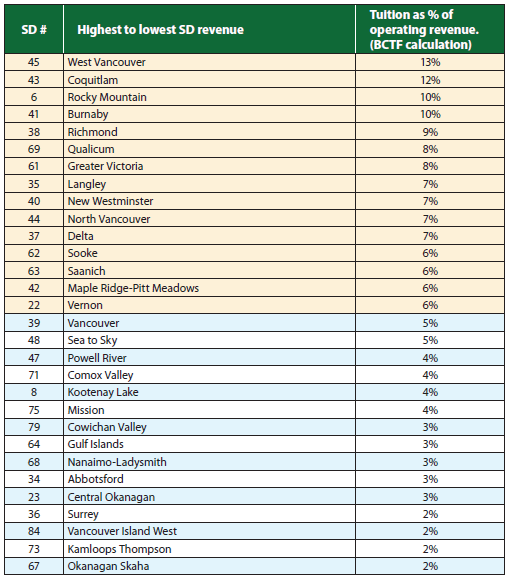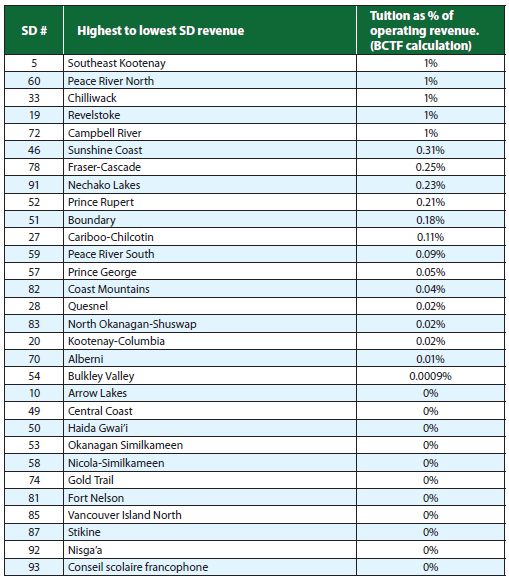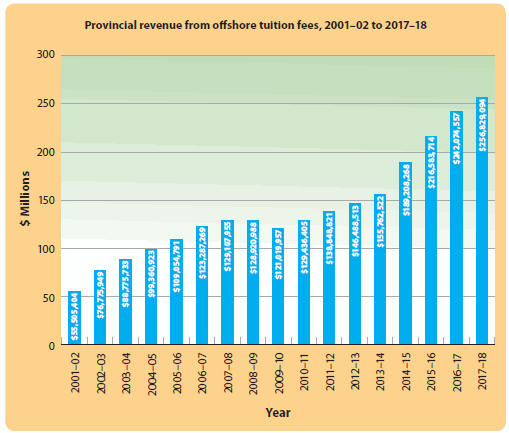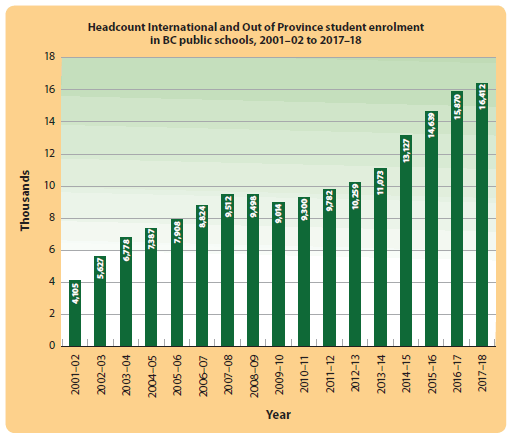The amount of tuition paid by international students to BC public school districts in the 2017–18 school year reached $256,829,0941. That is an increase by nearly $15 million compared to last year. This represents about 5% of total district revenues provincially, but the bulk of gains are concentrated in just 10 districts in Metro Vancouver and Greater Victoria.
K–12 International student tuition charges are $14,000 to $15,000 a year, depending on school district. The number of international students attending BC public schools, as reported by the BC Ministry of Education was 16,412 in 2017–182.2
The $15 million increase was about half the amount of previous years’ gains, indicating that growth in international student participation has slowed. Most school districts had no significant increase or decrease in revenues from this source compared to the previous year.
Four districts were exceptions, with increases in the percentage of their district budgets supplemented by international tuition: West Vancouver, Coquitlam, Burnaby and Rocky Mountain.
The financial inequalities between school districts created by international tuition are produced because most of the non-resident students end up in districts in the Metro Vancouver area and Southern Vancouver Island. With the exception of the Rocky Mountain district, known for its skiing attractions, school boards in the Interior and the North of the province attract very few international students. Many of the smaller districts attract no additional students at all.
The influx of these additional funds combined with provincial funding allows some school districts to offer more services to their students than others.Coquitlam,for example,added $37 million in extra revenue that could be used for increased staffing,teaching resources and technology. Vancouver had $26 million more revenue, Burnaby-$23 million,and Richmond gained $18 million.West Vancouver, with a much smaller student population, had over $9 million additional revenue.
The chart on "International and out of province tuition as a percentage of total school district revenue" gives an indicator of the levels of inequality.The school district that has the highest socio-economic status in the province, West Vancouver, gets to supplement the education of its students by 13%. Haida Gwai'i and some 15 other school districts get no extra funds for their students. About a dozen districts get nearly all the extra funding from international students.
Funding Review Rejects Fixing the Inequity
The Report of the Funding Review Panel,released in December 2018 was titled "Improving Equity and Accountability." It did recognize that "not all school districts have the same ability to generate revenues which can lead to inequities in the levels of services being provided to students across the province."
However,the Panel decided that no action should be taken to deal with the inequity.The panel said it "considered a range of options from status quo, to grant adjustments by the Ministry, to introducing a
mechanism within the model that would account for these revenues. However,the Panel concluded it does not make sense to penalize a select group of school districts for being entrepreneurial."
The Panel did identify that "a number of school districts highlighted the social benefit of BC resident students being exposed to different cultures." If this is a rationale for including international students,it should be seen as a challenge to the current inequity in what districts host international students. The large urban districts already have the most culturally diverse schools,while the districts in the North and Interior are much less diverse.This should be a positive argument to recommend that the Ministry takes responsibility for a system which ensures that all districts have the opportunity to host international students in order to provide equity in access to diverse cultures as part of the educational experience of both BC and international students.
Future prospects for international students
Several factors could place a limit on the growth of or even reduce the numbers of international students in BC public schools.
Local student enrolment increases experienced by many districts reduce the pressure to seek additional funding. The major rationale for recruiting international students was to gain funding in response to a combination of declining domestic enrolments and budget austerity in provincial grants.
Increasing enrolment brings in additional funding from the province, and increases demand for more classrooms, rather than having empty classrooms to fill. In addition,many districts have not succeeded in hiring enough teachers to fill all the positions required by the collective agreement, and adding more international students increases the numbers of teachers required.
In addition,basing funding on a market model produces vulnerabilities to external conditions.As an example,the one time in the past twenty years with a year-over-year decrease in international students was at the point of the Great Recession in 2008. An international financial crisis or a global outbreak of illness such as SARS could create a precipitous fall in the numbers of students.
Political uncertainty could also have an impact. China is the source of the largest number of international students in BC. The reputation of Canada in the wake of the arrest in Vancouver and possible extradition of a Huawei executive may affect Canada's image in China and have an impact on recruitment of students,which depends on Chinese government support.
The largest international student program,that of the Coquitlam school district,has a partnership with the Confucius Institute, a "soft power" agency of the Chinese government. The influence of the Institute on programs has been an issue,with the Toronto school board having rejected a partnership after public controversy. The district superintendent and some school board members were scheduled to visit China in 2019,with the trip paid for by the Chinese government. A late January poll by CKNW indicated that "90% of 628 respondents said trustees shouldn't go on the paid trip because the 'optics are terrible,' 6% said 'why not' and 4% going would be good to 'build bridges.'"
International and Out of Province student tuition as percentage of total SD revenue, 2017–18

International and Out of Province student tuition as percentage of total SD revenue, 2017–18


Source: BC public school districts' Audited Financial Statements, Schedule 2 A, International and Out of Province Tuition 2018.

Source: BC Ministry of Education, Student Headcount by Grade, posted on DataBC: BC public schools, all grades, all facilities, Non-resident students, 2017–18.
_______________________
- Source: BC School districts’ Audited Financial Statements, Schedule 2A. 2018.
- Source: Ministry of Education, Student Headcount by Grade, posted on DataBC: BC public schools, all grades, all facilities, Non-resident students